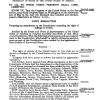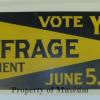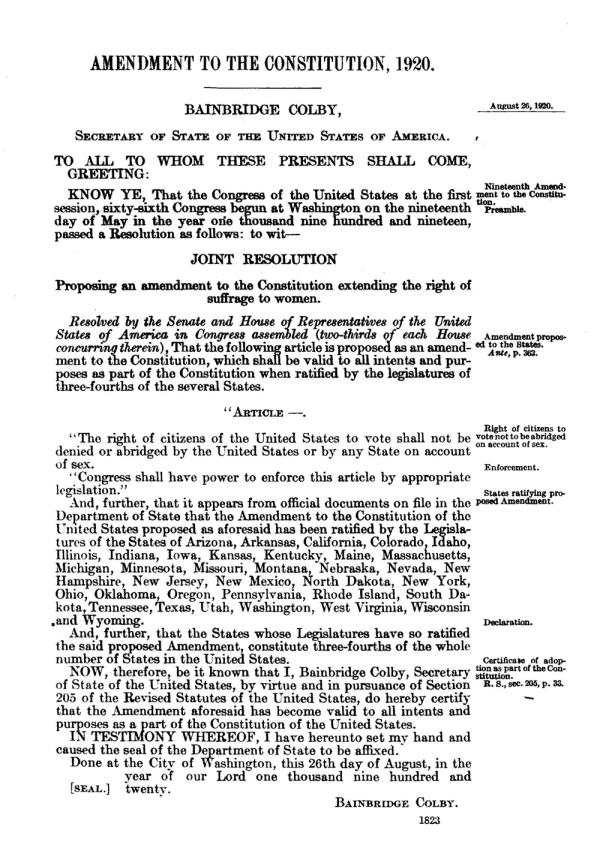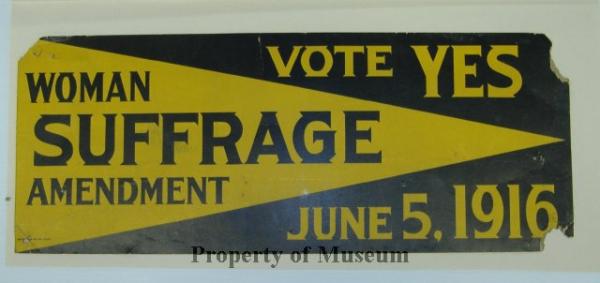Iowa Did it First...Kind Of.
| Grade | 9th -12th Grades | Class | U.S. History | Length of Lesson | 50 Minutes |
| Lesson Title | Iowa Did it First...Kind Of. |
| Unit Title | Political Movements of the Progressive Era |
| Unit Compelling Question | How was the state of Iowa's campaign for Women's Suffrage connected to that of the national referendum for Women's Suffrage? |
| Historical Context: 2018.019.004 The 19th Amendment came after a long struggle of women to gain their equal rights that began in the mid-1800s. In 1848, the first women's right convention was held at Seneca Falls, New York where 68 women and 32 men signed the Declaration of Sentiments. The Declaration called for laws to reflect the equality between men and women and that women too deserve unalienable rights that are guaranteed to men. This declaration began the women's movement to equality, with the first National Women's Rights Convention taking place in Massachusetts two years later in 1850. Women such as Susan B. Anthony and Elizabeth Cady Stanton formed the National Women's Suffrage Association to further promote the push for equality, with primary focus on gaining the right to vote. In 1893, Colorado became the first state to grant women the right to vote, followed by Utah and Idaho in 1896 and the state of Washington in 1910. By 1918, California, Oregon, Kansas, Arizona, Alaska, Illinois, Nevada, Montana, New York, Michigan, South Dakota and Oklahoma all granted women the right to vote. In 1919, the amendment drafted by Susan B. Anthony in 1878 is passed by the House of Representatives and the Senate. A year later on August 26 1920, the amendment is passed as a law by Secretary of State Bainbridge Colby. 2018.019.001 In 1870, a bill that would have removed the word "male" from Iowa's voting qualifications passed the Iowa legislature; however, a controversial speech given by a British women's suffrage supporter named Victoria Woodhull derailed women's suffrage in Iowa and other states. On June 5, 1916, Iowa men voted on another effort to grant voting rights to Iowa women. This sign encouraged men to vote yes on the referendum. The 1916 referendum was voted down, and women did not receive the right to vote at that time. Women finally received the right to vote when Iowa became the 10th state to ratify the 19th Amendment was ratified on July 2, 1919. Victoria Woodhull was a womens' rights advocate who fought for the right to vote, as well as the idea of free love where it is the woman's decision as much as a man's to marry, divorce or have children. Woodhull had many firsts for women: the first woman to run for President (this can be considered unofficial however since she was under 35), first woman to publish a newspaper and first to operate a brokerage wall firm on Wall Street. Woodhull often faced controversy for her beliefs in free love and the right for women to have open relationships and polygamous relationships such as men did. Woodhull publicly criticized Henry Ward Beecher for adultery and exposed his affair with another woman. Woodhull herself was charged with obscenity charges for sending out details of the affair. This event damaged her reputation among electors. |
|
| Lesson Supporting Question | |
| Lesson Overview | This lesson will cover the Iowa Women’s Suffrage movement during the Progressive Era. It will focus on the many different ways in which women campaigned for suffrage. The lesson plan examines tactics that women practiced and analyze them for their efficiency. Three major events will be the focus of the lesson plan. The 1894 partial suffrage referendum, the June 5th, 1916 Election, and the passage of the 19th Amendment. Within these, the students will look at how things changed from 1894-1916-1920. |
| Primary Sources Used |
|
| Resources Needed | https://docs.google.com/document/d/1PItl2_iWR_O6lslfrf4fEx77twUIGSMDJGXu9tGDM8g/edit https://www.legis.iowa.gov/docs/publications/iactc/62.1/CH0465.pdf http://publications.iowa.gov/135/1/history/7-7.html https://docs.google.com/presentation/d/1J2a6cnaxJenUACS5QIUy1gkrrlVW23EdomCyguRdbP8/edit#slide=id.p |
| Standard | |
| Lesson Target | Students will explain the three major events in Iowa's timeline for the Women's Suffrage Movement. These include the 1894 partial suffrage referendum, the June 5, 1916 Election, and the passage of the 19th Amendment.;Students will be able to create propaganda that Iowa Women Suffragists could have used during the Progressive Era to influence the vote. |
| Lesson Themes | Women's Experience, Civil Rights, Lawmaking, Political System |
|
| Formative Assessment (How will you use the formative assessments to monitor and inform instruction?) |
The formative assessment is attached to the questions related to the primary source. For a formative assessment, students will create their own form of propaganda that could have been used during the vote for suffrage in 1916. They are to incorporate evidence they have used from the lesson plan to fit their propaganda. Students can create any type of propaganda they want as long as it portrays a pro-suffrage message. |
| Summative Assessment (How does the lesson connect to planned summative assessment(s)?) |
| Author | McKinley Meyer | Created | Last Edited | ||||
| Reviewer: Chad Christopher, History Education, University of Northern Iowa | |||||||
| Lesson Plan Development Notes: Teaching Methods, University of Northern Iowa, Fall 2019 | |||||||




